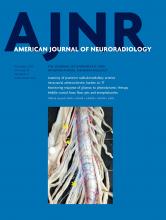Research ArticlePediatrics
Open Access
Topological Alterations of the Structural Brain Connectivity Network in Children with Juvenile Neuronal Ceroid Lipofuscinosis
T. Roine, U. Roine, A. Tokola, M.H. Balk, M. Mannerkoski, L. Åberg, T. Lönnqvist and T. Autti
American Journal of Neuroradiology December 2019, 40 (12) 2146-2153; DOI: https://doi.org/10.3174/ajnr.A6306
T. Roine
bRadiology, Child Psychiatry (M.M.)
dTurku Brain and Mind Center (T.R.), University of Turku, Turku, Finland
eDepartment of Neuroscience and Biomedical Engineering (T.R.), Aalto University School of Science, Espoo, Finland
U. Roine
bRadiology, Child Psychiatry (M.M.)
A. Tokola
bRadiology, Child Psychiatry (M.M.)
M.H. Balk
bRadiology, Child Psychiatry (M.M.)
M. Mannerkoski
bRadiology, Child Psychiatry (M.M.)
L. Åberg
cDepartment of Psychiatry (L.Å.), University of Helsinki and Helsinki University Hospital, Helsinki, Finland
T. Lönnqvist
fDepartment of Child Neurology (T.L.), Children's Hospital, University of Helsinki and Helsinki University, Helsinki, Finland.
T. Autti
bRadiology, Child Psychiatry (M.M.)

References
- 1.↵
- Tournier JD,
- Mori S,
- Leemans A.
- 2.↵
- Smith SM,
- Jenkinson M,
- Johansen-Berg H.
- 3.↵
- Jones DK,
- Knösche TR,
- Turner R.
- 4.↵
- 5.↵
- 6.↵
- Bullmore ET,
- Sporns O.
- 7.↵
- Jeurissen B,
- Leemans A,
- Jones DK, et al
- 8.↵
- Fischl B,
- van der Kouwe A,
- Destrieux C, et al
- 9.↵
- Rubinov M,
- Sporns O.
- 10.↵
- 11.↵
- van den Heuvel MP,
- Mandl RCW,
- Stam CJ, et al
- 12.↵
- 13.↵
- Lo CY,
- Wang PN,
- Chou KH, et al
- 14.↵
- 15.↵
- 16.↵
- Collins J,
- Holder GE,
- Herbert H, et al
- 17.↵
- Spalton DJ,
- Taylor DS,
- Sanders MD.
- 18.↵
- Jalanko A,
- Braulke T.
- 19.↵
- Autti T,
- Raininko R,
- Vanhanen SL.
- 20.↵
- 21.↵
- Autti T,
- Joensuu R,
- Åberg L.
- 22.↵
- Autti T,
- Raininko R,
- Santavuori P, et al
- 23.↵
- Roine U,
- Roine TJ,
- Hakkarainen A, et al
- 24.↵
- Tournier J-D,
- Calamante F,
- Connelly A.
- 25.↵
- Basser PJ,
- Mattiello J,
- LeBihan D.
- 26.↵
- 27.↵Movement Disorder Society Task Force on Rating Scales for Parkinson’s Disease. The Unified Parkinson’s disease rating scale (UPDRS): status and recommendations. Mov Disord 2003;18:738–50 doi:10.1002/mds.10473 pmid:12815652
- 28.↵
- Leemans A,
- Jones DK.
- 29.↵
- Jeurissen B,
- Sijbers J, et al
- Leemans A
- 30.↵
- 31.↵
- Destrieux C,
- Fischl B,
- Dale A, et al
- 32.↵
- Tournier JD,
- Calamante F,
- Connelly A.
- 33.↵
- 34.↵
- Saramäki J,
- Kivelä M,
- Onnela JP, et al
- 35.↵
- Watts DJ,
- Strogatz SH.
- 36.↵
- 37.↵
- Freeman LC.
- 38.↵
- Shapleske J,
- Rossell SL,
- Woodruff PW, et al
- 39.↵
- Binder JR,
- Frost JA,
- Hammeke TA, et al
- 40.↵
- Stoeckel C,
- Gough PM,
- Watkins KE, et al
- 41.↵
- Rushworth MF,
- Behrens TE,
- Johansen-Berg H.
- 42.↵
- Déjerine J.
- 43.↵
- Devlin JT,
- Matthews PM,
- Rushworth M.
- 44.↵
- Catani M,
- Jones DK,
- Ffytche DH.
- 45.↵
- Poldrack RA,
- Wagner AD,
- Prull MW, et al
- 46.↵
- Hartwigsen G,
- Baumgaertner A,
- Price CJ, et al
- 47.↵
- Arnett PA,
- Swanson SJ,
- Hammeke TA.
- 48.↵
- Kertesz A,
- Lau WK,
- Polk M.
- 49.↵
- Adam M,
- Ardinger H,
- Pagon R, et al.
- Mole SE,
- Williams RE
- 50.↵
- Patterson K,
- Brown WD,
- Wise R, et al
- 51.↵
- Price CJ,
- Wise RJS,
- Watson JDG, et al
- 52.↵
- Bookheimer SY,
- Zeffiro TA,
- Blaxton T, et al
- 53.↵
- Machielsen WC,
- Rombouts SA,
- Barkhof F, et al
- 54.↵
- Bogousslavsky J,
- Miklossy J,
- Deruaz J-P, et al
- 55.↵
- Brunet E,
- Sarfati Y,
- Hardy-Baylé MC, et al
- 56.↵
- 57.↵
- Cho S,
- Metcalfe AWS,
- Young CB, et al
- 58.↵
- Isenberg N,
- Silbersweig D,
- Engelien A, et al
- 59.↵
- Damasio A,
- Yamada T,
- Damasio H, et al
- 60.↵
- Meadows JC.
- 61.↵
- Kanwisher N.
- 62.↵
- Meadows JC.
- 63.↵
- Damasio AR,
- Damasio H,
- Van Hoesen GW.
- 64.↵
- Barton JJS,
- Press DZ,
- Keenan JP, et al
- 65.↵
- Takahashi N,
- Kawamura M.
- 66.↵
- 67.↵
- 68.↵
- Tournier JD,
- Calamante F,
- Connelly A.
- 69.↵
- Farquharson S,
- Tournier JD,
- Calamante F, et al
- 70.↵
- 71.↵
- 72.↵
- Roine T,
- Jeurissen B,
- Perrone D, et al
In this issue
American Journal of Neuroradiology
Vol. 40, Issue 12
1 Dec 2019
Advertisement
T. Roine, U. Roine, A. Tokola, M.H. Balk, M. Mannerkoski, L. Åberg, T. Lönnqvist, T. Autti
Topological Alterations of the Structural Brain Connectivity Network in Children with Juvenile Neuronal Ceroid Lipofuscinosis
American Journal of Neuroradiology Dec 2019, 40 (12) 2146-2153; DOI: 10.3174/ajnr.A6306
0 Responses
Topological Alterations of the Structural Brain Connectivity Network in Children with Juvenile Neuronal Ceroid Lipofuscinosis
T. Roine, U. Roine, A. Tokola, M.H. Balk, M. Mannerkoski, L. Åberg, T. Lönnqvist, T. Autti
American Journal of Neuroradiology Dec 2019, 40 (12) 2146-2153; DOI: 10.3174/ajnr.A6306
Jump to section
Related Articles
Cited By...
This article has been cited by the following articles in journals that are participating in Crossref Cited-by Linking.
- Alessandro Simonati, Ruth E. WilliamsFrontiers in Neurology 2022 13
- John R. Ostergaard, Hemanth R. Nelvagal, Jonathan D. CooperFrontiers in Neurology 2022 13
- U. Roine, A.M. Tokola, T. Autti, T. RoineAmerican Journal of Neuroradiology 2023 44 1
More in this TOC Section
Pediatrics
Similar Articles
Advertisement











